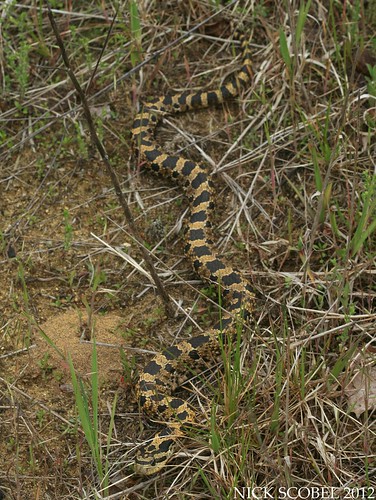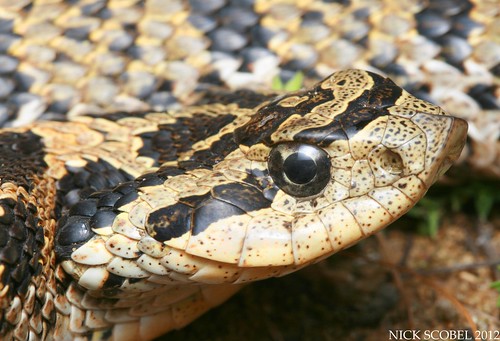Eastern Hognose Snake - Heterodon platirhinos
A beautiful golden yellow adult, easily the
nicest looking example of the species I've seen. Hogs are extremely variable in coloration, with some individuals even being completely gray or black with little to no patterning. This is only the sixth
live specimen I've seen in my lifetime, and my first of the year. It was found in an open field with sparse cover and plenty of open sandy soil which is adjacent to a large tract of Oak-Pine forest.
The upturned rostral scale where this species gets its namesake from is easily seen in the photo above. Hogs use this adaptive trait to burrow into the sandy soils of the areas the inhabit. This could be in search of shelter, food, or to excavate a chamber for eggs. Females generally do this in early or mid June and the young usually hatch out in August or September. I've written before about their impressive defensive displays which entail a flattened neck and high pitched hiss, so I've decided to attach a video of this behavior.
This snake was a little unwilling to play dead as much as other hogs I've seen, but it did eventually do so. It is always a treat to find this species in the field as I don't see them very often. I'll close with another short video of this beauty disappearing into the field, I can only hope I'll see one again before the year is over.




So cool Nick! We were pulling garlic mustard at our local nature center yesterday and my son said he saw a small hognose. Do you think that's possible? He said it was about a foot long and had a checkered pattern. He tried to catch it, but it was too quick. I also found a small dead one in Ohio a few weekends ago.
ReplyDeleteCindi
It's hard to know, wouldn't be too far outside the realm of possibility. Hogs are probably more common in the state than people think, its just that they are so secretive.
ReplyDeleteI grew up in Romulus, MI right next to Metro Airport. We had a 5 acre parcel that was surrounded by many more acres of undeveloped Airport land. Hognosed snakes were every bit as common in the woods behind our house as garter snakes, they were everywhere. My brother and I would catch them all summer long. We used to get a kick out it when they would play dead. So, if you're looking for hognosed snakes in SE Michigan, try the wooded/swampy areas in and around Romulus, they're all over the place.
DeleteI know there is currently one residing on the 20th hole at Willow Metropark Disc Golf Course. I have seen him over a dozen times in the past three weeks. He/she is about 30" and is regularly sunning on a small stump just before you reach the basket on the right side of the fairway, about 8-10ft before the turn in the path. He/she commonly retreats just under the fallen log next to the stump. It's a darker color...
ReplyDeleteI also have seen multiple smaller Hognose at this location, a 5-6ft black colored snake near the large Oak tree in the middle of hole 14's fairway. Blue Racer...? It was large and quick, definitely blackish-blue in color and had the same girth as a cucumber...
There is a recent report in Saginaw MI of a snake that a man found in the engine compartment of his truck that resembles this snake. The Sagainw County Sheriffs Department was involved(the man drove to the department asking for assistance)so there is a news story available. They were unable to identify the snake. Perhaps you can assist.
ReplyDeleteI think I just had one in my backyard in far SW MIchigan (Berrien Cty). Is there someone I can send a photo to for ID?
ReplyDeleteThese snakes live on my property in Monroe County Michigan in pretty decent numbers. We find at least 10 or so a year. They are very cool. I recognize them because we had them as pets as children. We live in a very sandy wooded area. 8.4 acres. Very Cool
ReplyDeleteWe saw one while walking the trail at P.J. Hoffmaster State Park.
ReplyDelete